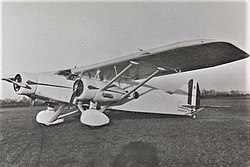Caproni ca.133
| Caproni ca.133 | |
|---|---|

|
|
| Type: |
Transporter bomber reconnaissance |
| Design country: | |
| Manufacturer: | |
| First flight: |
September 16, 1934 |
| Commissioning: |
1935 |
| Number of pieces: |
404 military + 12 civil |
The Caproni Ca.133 was a three-engine Italian transport aircraft or bomber of the Regia Aeronautica in World War II and the post-war period.
history
The Ca.133 was designed by Rudolfo Verduzio at Caproni in 1934. The machine was based on the Caproni Ca.101 from 1927. The first flight took place in 1934 and series production began in 1935. There were both civil and military variants of the aircraft. The airline Ala Littoria flew a variant for a maximum of 16 passengers. The differences to the Ca.101 were among other things the fairing of the engines to reduce the air resistance, fairings on the main landing gear, different landing flaps and a modified tail unit. The military version was used early in the Italo-Ethiopian War of 1935/36. The troop transport Ca.133T could hold up to 18 soldiers. Some Caproni Ca.133 were also exported to Austria in the mid-1930s. There they were used, among other things, in bomber squadron 1B of the Aviation Regiment No. 2 of the Austrian Air Force.
In the Second World War, around 133 were deployed on all fronts. In addition to troop transport, they served as light bombers and ambulance aircraft. The machines were armed with four 7.7 mm machine guns or 500 kg bombs. One machine gun fired from the left door and another was mounted in an open position on the top of the fuselage just behind the wings. Two machine guns were deployed from openings in the underside of the fuselage. The landing gear was rigid, and two of the three 460 hp Piaggio Stella VII.C 16 engines were suspended in motor gondolas under the wings.
The Ca.148 later became the successor to the Ca.133, which was in use long after the Second World War. This model was introduced in 1938. Changes were a cockpit that was moved forward by about 0.90 m and the relocation of the large cabin door behind the wing's trailing edge. On previous models, the door was under the left wing. A reinforced chassis was also installed. This version still flew with the Italian post-war Air Force. The ca.148 was basically unarmed. The passenger capacity was 18 instead of 16 for the ca.133.
variants
- Approx . 133 - bombers and transporters
- Approx . 133S - ambulance aircraft
- About 133T - troop transport
- Approx . 148 - extended successor version (civil and military transporter)
Military users
- Aeronautica Militare (after the war)
- Royal Air Force (a booty machine)
Technical specifications
| Parameter | Data |
|---|---|
| crew | 5 (bomber) / 2 (transporter) |
| length | 15.36 m |
| span | 21.34 m |
| Wing area | 65 m² |
| height | 4.0 m |
| Empty mass | 4000 kg |
| Takeoff mass | 6525 kg |
| drive | 3 × 7-cylinder radial engines Piaggio Stella VII.C 16; 460 PS each (approx. 340 kW) |
| Top speed | 280 km / h |
| Cruising speed | 230 km / h |
| Service ceiling | 5500 m |
| Range | 1350 km |
| Armament | 4 × 7.7 mm machine guns, 500 kg bombs |
swell
- Aero. Volume 47, Marshall Cavendish International Ltd., London 1984.
- Chris Chant: World War II warplanes. ISBN 3-8112-1740-2 .